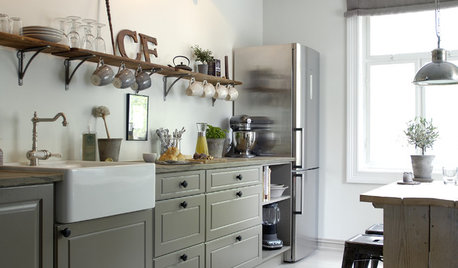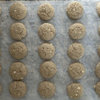Bone Broth Question
petra_gw
13 years ago
Featured Answer
Sort by:Oldest
Comments (42)
carmen_grower_2007
13 years agolast modified: 9 years agopetra_gw
13 years agolast modified: 9 years agoRelated Discussions
What NOT to put in Vegetable & Bone Broth?
Comments (10)You must have missed reading a copy of "Nourishing Broth" by Sally Fallon Morell and Kaayla T. Daniel, PhD, CCN. A book loaded with information and recipes. The Cliffs Notes version is found here: Broth is Beautiful - http://www.westonaprice.org/health-topics/broth-is-beautiful/ I pretty much like bone broth without a lot of other things in it. I can't/don't use onion or garlic in anything anymore, since gallbladder surgery, so even those two are not necessary. I usually add some carrots and celery (be careful, the celery ends and leaves can be bitter), and some parsley or parsley stems (if I happen to have a bundle of them), and that's about it for the bone broth I make. If I want to make vegetable broth, that's a completely different "beast". I learned to make vegetable broth from trimmings and less-than-perfect vegetables when I went on a macrobiotic diet back in the late 1980's, and made it a habit ever since. In vegetable broth I avoid foods from the brassica family --- broccoli, cabbage, Brussels sprouts, cauliflower, kale, rutabagas, and turnips, which give a strong/bitter flavor. A few outer cabbage leaves are okay, but I wouldn't use a lot of them. Artichokes are also too strong for broth. I avoid using corn because it can make the broth cloudy (from the starch). For both bone broth and vegetable broth, avoid using dried/powdered versions of herbs - FRESH IS BEST! -Grainlady...See MoreChicken bone broth? Slow cooker? Vegetables?
Comments (39)We've had lots of discussions about the difference between stock and broth (not much, but "stock" usually refers to something used as an ingredient and broth is used to mean a finished rich plain soup). We also talked about why "bone" up topic. Some are made with mostly bones and are cooked a very long time to get the minerals out of the bones. Others are made with mostly meat or meaty bones and are cooked for less time, until the meat is all cooked out and what bones there are have yielded flavor but aren't soft and/or friable unless they're tiny. A third option is made with mostly bones and vegetables, but not cooked long enough to really pull all the minerals out of the bones. The first one is "bone" because it's about the bones. And often broth because it's meant to be consumed straight as soup....See MoreHam bone broth advice . . .
Comments (18)I agree. Save the freezer space that broth takes up. At the beginning of lockdown mid March, I ordered a big bag of chicken backs and beef bones. Wrapped tight in packages for future broth. (I did make a batch right away)...made more broth as I had extra celery, leek tops, carrots, onions. I also purchased a ham that had a good decent fridge date and tackled that in small packages for soups, frittatas, etc. Wrapped the bone tight and made stock a couple months later. Takes the pressure off to save a chore for later or when desired....snow day pleasures. Fresh batch of warm soup. Maybe a bit odd?, but I learned this method for whole hams from an x-boyfriends Filipino mother 40 years ago. Soak the whole ham in 2-3 rinses of cold water in a stock pot. Third rinse overnight in the fridge. (or a cooler with ice packs if fridge space is limited). Fresh water next day with aromatics. (bay leaves, peppercorns, etc). Bring up to a simmer, then 1/2 hour. Drain and oven roast whole for a crowd, or a few slices roasted for just us for that nights meal. The rest goes in packages for the future once cooled. Freezer packs. Similar to prepping salt cod. A shocking amount of salt is removed. Just enough salt removed but not shocking. We are very sensitive to salt not using much daily....See MoreFood Find: Coconut Lime Chicken Bone Broth
Comments (3)Well that did it. My stomach has a bug and reading the topic heading did me in. LOL Maybe if you took "Bone" out it'd be okay....See MoreTeresa_MN
13 years agolast modified: 9 years agopetra_gw
13 years agolast modified: 9 years agoJohn Liu
13 years agolast modified: 9 years agoannie1992
13 years agolast modified: 9 years agodcarch7 d c f l a s h 7 @ y a h o o . c o m
13 years agolast modified: 9 years agodcarch7 d c f l a s h 7 @ y a h o o . c o m
13 years agolast modified: 9 years agograinlady_ks
13 years agolast modified: 9 years agopetra_gw
13 years agolast modified: 9 years agopetra_gw
13 years agolast modified: 9 years agograinlady_ks
13 years agolast modified: 9 years agoUser
13 years agolast modified: 9 years agopetra_gw
13 years agolast modified: 9 years agorachelellen
13 years agolast modified: 9 years agopetra_gw
13 years agolast modified: 9 years agoTeresa_MN
13 years agolast modified: 9 years agoJohn Liu
13 years agolast modified: 9 years agodcarch7 d c f l a s h 7 @ y a h o o . c o m
13 years agolast modified: 9 years agobunnyman
13 years agolast modified: 9 years agopetra_gw
13 years agolast modified: 9 years agogreenmulberry
13 years agolast modified: 9 years agoTeresa_MN
13 years agolast modified: 9 years agogypsyrose
13 years agolast modified: 9 years agoJohn Liu
13 years agolast modified: 9 years agococonut_nj
13 years agolast modified: 9 years agometaxa
13 years agolast modified: 9 years agorachelellen
13 years agolast modified: 9 years agoJohn Liu
13 years agolast modified: 9 years agorachelellen
13 years agolast modified: 9 years agodcarch7 d c f l a s h 7 @ y a h o o . c o m
13 years agolast modified: 9 years agolisbet
13 years agolast modified: 9 years agopetra_gw
13 years agolast modified: 9 years agobunnyman
13 years agolast modified: 9 years agoJohn Liu
13 years agolast modified: 9 years agodgkritch
13 years agolast modified: 9 years agogreenmulberry
13 years agolast modified: 9 years agoTeresa_MN
13 years agolast modified: 9 years agocountrygal_905
13 years agolast modified: 9 years agograinlady_ks
13 years agolast modified: 9 years agocountrygal_905
13 years agolast modified: 9 years ago
Related Stories

DECORATING GUIDESBone Made Strong Showing at High Point Market
From small boxes to big lighting fixtures, bone and bone inlay had a solid presence at the 2012 High Point Market
Full Story
MATERIALSShow Off the Bones of Your Home With Exposed Finishes
There can be beauty in raw materials. Display them with care, and the effect is surprisingly warm and welcoming
Full Story
REMODELING GUIDESConsidering a Fixer-Upper? 15 Questions to Ask First
Learn about the hidden costs and treasures of older homes to avoid budget surprises and accidentally tossing valuable features
Full Story
FEEL-GOOD HOMEThe Question That Can Make You Love Your Home More
Change your relationship with your house for the better by focusing on the answer to something designers often ask
Full Story
WORKING WITH PROS12 Questions Your Interior Designer Should Ask You
The best decorators aren’t dictators — and they’re not mind readers either. To understand your tastes, they need this essential info
Full Story
ARCHITECTURETell a Story With Design for a More Meaningful Home
Go beyond a home's bones to find the narrative at its heart, for a more rewarding experience
Full Story
BEFORE AND AFTERSKitchen Rehab: Don’t Nix It, Fix It
A small makeover makes a big impact in a traditional kitchen in Atlanta with great bones
Full Story
KITCHEN DESIGNKitchen of the Week: Vintage Flair for a Modern Norwegian Family
Honoring the home's 1920s bones and her family's needs, a designer makes over her kitchen with an addition
Full Story
KITCHEN DESIGNA Cook’s 6 Tips for Buying Kitchen Appliances
An avid home chef answers tricky questions about choosing the right oven, stovetop, vent hood and more
Full Story
MOST POPULAR10 Things to Ask Your Contractor Before You Start Your Project
Ask these questions before signing with a contractor for better communication and fewer surprises along the way
Full Story





annie1992